TimTaiLieu.vn - Tài liệu, ebook, giáo trình, đồ án, luận văn
Tổng hợp tất cả tài liệu, ebook, giáo trình Khối Ngành Kinh Tế chọn lọc và hay nhất.

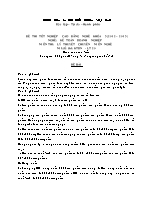 Đề và đáp án thi tốt nghiệp cao đẳng nghề khóa 5 - Nghề: Kế toán doanh nghiệp - Mã đề thi: KTDN - LT 20
Đề và đáp án thi tốt nghiệp cao đẳng nghề khóa 5 - Nghề: Kế toán doanh nghiệp - Mã đề thi: KTDN - LT 20ĐỀ BÀI Câu 1: (2 điểm) Trình bày cách phân loại tài sản cố định theo hình thái biểu hiện và công dụng kinh tế. Ý nghĩa của cách phân loại này? So sánh sự khác nhau giữa nguyên vật liệu, công cụ dụng cụ, tài sản cố định. (Về khái niệm, đặc điểm, yêu cầu quản lý). Câu 2: (5 điểm) Một doanh kinh doanh tổng hợp trong kỳ có các số liệu sau: I. DN ...
 2 trang | Chia sẻ: nguyenlinh90 | Ngày: 19/07/2019 | Lượt xem: 939 | Lượt tải: 2
2 trang | Chia sẻ: nguyenlinh90 | Ngày: 19/07/2019 | Lượt xem: 939 | Lượt tải: 2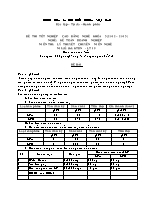 Đề và đáp án thi tốt nghiệp cao đẳng nghề khóa 5 - Nghề: Kế toán doanh nghiệp - Mã đề thi: KTDN - LT 19
Đề và đáp án thi tốt nghiệp cao đẳng nghề khóa 5 - Nghề: Kế toán doanh nghiệp - Mã đề thi: KTDN - LT 19ĐỀ BÀI Câu 1: (2 điểm) Trình bày nội dung các chỉ tiêu mức hạ giá thành và tỷ lệ hạ giá thành của những sản phẩm so sánh được? Ý nghĩa hạ giá thành sản phẩm của doanh nghiệp? Phân biệt giữa chi phí sản xuất kinh doanh và giá thành sản phẩm trong doanh nghiệp. Câu 2: (5 điểm) Tại một doanh nghiêp có tài liệu sau: I/ Tài liệu năm báo cáo 1, Tì...
 2 trang | Chia sẻ: nguyenlinh90 | Ngày: 19/07/2019 | Lượt xem: 1153 | Lượt tải: 4
2 trang | Chia sẻ: nguyenlinh90 | Ngày: 19/07/2019 | Lượt xem: 1153 | Lượt tải: 4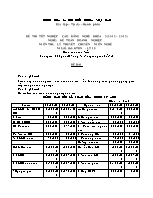 Đề và đáp án thi tốt nghiệp cao đẳng nghề khóa 5 - Nghề: Kế toán doanh nghiệp - Mã đề thi: KTDN - LT 18
Đề và đáp án thi tốt nghiệp cao đẳng nghề khóa 5 - Nghề: Kế toán doanh nghiệp - Mã đề thi: KTDN - LT 18ĐỀ BÀI Câu 1: (2 điểm) Trình bày nội dung cách xác định nhu cầu vốn lưu động theo phương pháp gián tiếp trong doanh nghiệp. Câu 2: (5 điểm) Có tài liệu của một doanh nghiệp như sau: BẢNG CÂN ĐỐI KẾ TOÁN CỦA CÔNG TY ABC
 2 trang | Chia sẻ: nguyenlinh90 | Ngày: 19/07/2019 | Lượt xem: 1128 | Lượt tải: 2
2 trang | Chia sẻ: nguyenlinh90 | Ngày: 19/07/2019 | Lượt xem: 1128 | Lượt tải: 2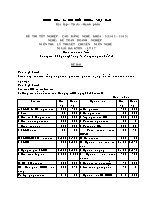 Đề và đáp án thi tốt nghiệp cao đẳng nghề khóa 5 - Nghề: Kế toán doanh nghiệp - Mã đề thi: KTDN - LT 17
Đề và đáp án thi tốt nghiệp cao đẳng nghề khóa 5 - Nghề: Kế toán doanh nghiệp - Mã đề thi: KTDN - LT 17ĐỀ BÀI Câu 1:(2 điểm) Trình bày chỉ tiêu tổng hợp đánh giá hiệu quả sử dụng vốn cố định của doanh nghiệp. Câu 2:(5 điểm) Tại một DN có tài liệu sau: 1. Bảng cân đối kế toán của Công ty ABC ngày 31/12/năm N
 3 trang | Chia sẻ: nguyenlinh90 | Ngày: 19/07/2019 | Lượt xem: 1350 | Lượt tải: 2
3 trang | Chia sẻ: nguyenlinh90 | Ngày: 19/07/2019 | Lượt xem: 1350 | Lượt tải: 2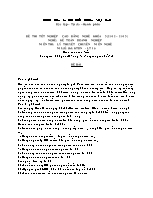 Đề và đáp án thi tốt nghiệp cao đẳng nghề khóa 5 - Nghề: Kế toán doanh nghiệp - Mã đề thi: KTDN - LT 16
Đề và đáp án thi tốt nghiệp cao đẳng nghề khóa 5 - Nghề: Kế toán doanh nghiệp - Mã đề thi: KTDN - LT 16ĐỀ BÀI Câu 1 (2 điểm) Đầu tư dài hạn của doanh nghiệp là gì? Phân tích các nhân tố ảnh hưởng tới các quyết định đầu tư dài hạn của doanh nghiệp? Tính bài tập sau: Ông A vay thế chấp ngân hàng một khoản tiền 500 triệu đồng với mức lãi suất là 12%/năm. Nếu hợp đồng vay qui định trả dần mỗi năm 1 lần trong thời hạn 5 năm (bắt đầu sau 1 năm kể từ ngà...
 2 trang | Chia sẻ: nguyenlinh90 | Ngày: 19/07/2019 | Lượt xem: 1113 | Lượt tải: 2
2 trang | Chia sẻ: nguyenlinh90 | Ngày: 19/07/2019 | Lượt xem: 1113 | Lượt tải: 2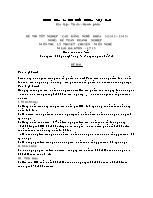 Đề và đáp án thi tốt nghiệp cao đẳng nghề khóa 5 - Nghề: Kế toán doanh nghiệp - Mã đề thi: KTDN - LT 15
Đề và đáp án thi tốt nghiệp cao đẳng nghề khóa 5 - Nghề: Kế toán doanh nghiệp - Mã đề thi: KTDN - LT 15ĐỀ BÀI Câu 1 (2 điểm) Trình bày những đặc trưng của cổ phiếu ưu đãi? Phân tích những điểm lợi và bất lợi của việc huy động vốn bằng việc phát hành cổ phiếu ưu đãi tại doanh nghiệp. Câu 2:(5 điểm) Công ty A chuyên sản xuất nước giải khát. Hai sản phẩm của công ty là nước ngọt và rượu nhẹ, trong tháng 1/2010 có các nghiệp vụ và hoạt động kinh t...
 2 trang | Chia sẻ: nguyenlinh90 | Ngày: 19/07/2019 | Lượt xem: 1067 | Lượt tải: 2
2 trang | Chia sẻ: nguyenlinh90 | Ngày: 19/07/2019 | Lượt xem: 1067 | Lượt tải: 2 Đề và đáp án thi tốt nghiệp cao đẳng nghề khóa 5 - Nghề: Kế toán doanh nghiệp - Mã đề thi: KTDN - LT 14
Đề và đáp án thi tốt nghiệp cao đẳng nghề khóa 5 - Nghề: Kế toán doanh nghiệp - Mã đề thi: KTDN - LT 14ĐỀ BÀI Câu 1: (2 điểm) So sánh thuê vận hành và thuê tài chính? Phân tích các điểm lợi và bất lợi của việc thuê tài chính của doanh nghiệp phi tài chính Câu 2: (5 điểm) Có tình hình về tài sản cố định (TSCĐ) của doanh nghiệp (DN) A như sau: I. Tài liệu năm báo cáo: 1. Số dư của tài khoản TSCĐ trên bảng cân đối kế toán ngày 30/9 là 18.700 t...
 2 trang | Chia sẻ: nguyenlinh90 | Ngày: 19/07/2019 | Lượt xem: 932 | Lượt tải: 2
2 trang | Chia sẻ: nguyenlinh90 | Ngày: 19/07/2019 | Lượt xem: 932 | Lượt tải: 2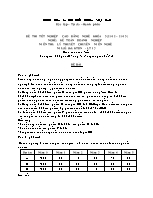 Đề và đáp án thi tốt nghiệp cao đẳng nghề khóa 5 - Nghề: Kế toán doanh nghiệp - Mã đề thi: KTDN - LT 13
Đề và đáp án thi tốt nghiệp cao đẳng nghề khóa 5 - Nghề: Kế toán doanh nghiệp - Mã đề thi: KTDN - LT 13ĐỀ BÀI Câu 1: (2 điểm) Trình bày nội dung và phương pháp tính thuế xuất khẩu, nhập khẩu của doanh nghiệp? Xác định thuế xuất khẩu, nhập khẩu của công ty Z biết trong kỳ kinh doanh có các nghiệp vụ phát sinh như sau: 1. Nhập khẩu 12.000 sản phẩm N theo giá CIF qui ra đồng Việt Nam là 50.000đ/sp. Theo biên bản giám định của các cơ quan chức năng c...
 2 trang | Chia sẻ: nguyenlinh90 | Ngày: 19/07/2019 | Lượt xem: 961 | Lượt tải: 2
2 trang | Chia sẻ: nguyenlinh90 | Ngày: 19/07/2019 | Lượt xem: 961 | Lượt tải: 2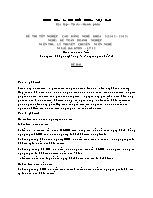 Đề và đáp án thi tốt nghiệp cao đẳng nghề khóa 5 - Nghề: Kế toán doanh nghiệp - Mã đề thi: KTDN - LT 12
Đề và đáp án thi tốt nghiệp cao đẳng nghề khóa 5 - Nghề: Kế toán doanh nghiệp - Mã đề thi: KTDN - LT 12ĐỀ BÀI Câu 1: ( 2 điểm) Trình bày khái niệm và giải thích công thức tính lãi đơn và lãi kép? Tính bài tập: Ông A còn 10 năm nữa về hưu, ông dự tính khi về hưu sẽ có một khoản tiền để giải quyết nhu cầu chi tiêu của gia đình bằng cách: ngay từ bây giờ, mỗi năm 1 lần ông gửi đều đặn 1 khoản tiền 10 triệu đồng vào ngân hàng với lãi suất 10%/năm theo...
 3 trang | Chia sẻ: nguyenlinh90 | Ngày: 19/07/2019 | Lượt xem: 1035 | Lượt tải: 2
3 trang | Chia sẻ: nguyenlinh90 | Ngày: 19/07/2019 | Lượt xem: 1035 | Lượt tải: 2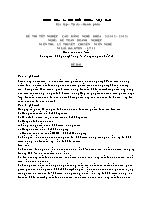 Đề và đáp án thi tốt nghiệp cao đẳng nghề khóa 5 - Nghề: Kế toán doanh nghiệp - Mã đề thi: KTDN - LT 11
Đề và đáp án thi tốt nghiệp cao đẳng nghề khóa 5 - Nghề: Kế toán doanh nghiệp - Mã đề thi: KTDN - LT 11ĐỀ BÀI Câu 1: (2 điểm) Trình bày khái niệm và đặc điểm trái phiếu của doanh nghiệp? Phân tích những điểm lợi và điểm bất lợi khi phát hành trái phiếu tại doanh nghiệp? Tính bài tập sau: Trái phiếu B có mệnh giá 1 triệu đồng, lãi suất 10%/năm. Trái phiếu này đang bán trên thị trường với giá là 1,1 triệu đồng. Ông A quyết định mua trái phiếu này. V...
 2 trang | Chia sẻ: nguyenlinh90 | Ngày: 19/07/2019 | Lượt xem: 1308 | Lượt tải: 2
2 trang | Chia sẻ: nguyenlinh90 | Ngày: 19/07/2019 | Lượt xem: 1308 | Lượt tải: 2
Website đang trong thời gian thử nghiệm, chờ xin giấy phép của Bộ TT & TT.

